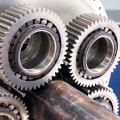The Triumph TR3 has a long and storied history, having been first introduced in 1955 as a replacement for the popular TR2. The TR3 was designed to be faster and more powerful than its predecessor, with a new two-litre engine, four-speed gearbox, and improved suspension. It quickly became a classic sports car, and was produced until 1962, when it was replaced by the TR4. Over the years, the TR3 has become an iconic symbol of British motoring excellence, and its distinctive styling and performance have made it a favourite among classic car enthusiasts. From its beginnings in the 1950s, to its current status as a classic sports car, the Triumph TR3 has been a favourite of drivers across the world. Learn more about the history of this classic car in this article.
The Origins of the Triumph TR3:
The Triumph TR3 was introduced in 1955 as a replacement for the TR2. Developed by Standard Motor Company, the TR3 was designed to be a more refined and powerful version of its predecessor. It was equipped with a 2.0 liter four-cylinder engine, a four-speed manual transmission, and independent front suspension.The TR3 also featured a distinctive body style with a curved grille and round headlights. This gave the car a unique look that helped it stand out from other sports cars of the time.
Design:
The Triumph TR3 was designed with performance in mind. It featured a lightweight body that was aerodynamic and allowed for better handling. The interior was also designed to be comfortable and luxurious, with leather seats, wood trim, and chrome accents.The car also came with several features such as wind-up windows, an adjustable steering wheel, and a fold-down soft top. All of these features helped make the TR3 a popular choice among sports car enthusiasts.
Engines:
The original TR3 came equipped with a 2.0 liter four-cylinder engine that produced 90 horsepower. This engine was capable of going from 0-60 mph in just over 11 seconds and had a top speed of around 110 mph. In 1957, Triumph offered the optional “big bore” engine which had an increased displacement of 2.2 liters and produced 105 horsepower.This engine could reach a top speed of nearly 120 mph.
Racing Heritage:
The Triumph TR3 had great success in both amateur and professional racing events. It won the prestigious 12 Hours of Sebring race in 1959 and was also successful in other endurance races such as the 24 Hours of Le Mans. The car also had success in rally racing, taking first place at the 1958 Monte Carlo Rally.Popular Culture:
The Triumph TR3 has been featured in numerous movies and television shows over the years. One of the most notable appearances was in the 1960s spy film “The Ipcress File” starring Michael Caine.The car was also featured in the hit TV show “The Saint” starring Roger Moore. Other appearances include films such as “Foul Play” (1978) and “The Italian Job” (1969).The car was also featured in the hit TV show “The Saint” starring Roger Moore. Other appearances include films such as “Foul Play” (1978) and “The Italian Job” (1969).
Conclusion:
The Triumph TR3 was a classic British sports car that was popular for its distinctive styling and performance. It had great success in both amateur and professional racing events, as well as being featured in various movies and TV shows. With its powerful engines and iconic design, the Triumph TR3 remains one of the most beloved classic cars of all time. The Triumph TR3 was a classic British sports car that was popular for its distinctive styling and performance. It had great success in both amateur and professional racing events, as well as being featured in various movies and TV shows. With its powerful engines and iconic design, the Triumph TR3 remains one of the most beloved classic cars of all time.Popular Culture
The Triumph TR3 was a popular car in its time, and it was featured in a number of films, books, and TV shows.In the 1956 movie 'The Cool and the Crazy', the main characters drove a Triumph TR3. The car was also featured in the classic British movie 'The Italian Job' and the U.S. TV show 'Route 66'. The car was also featured in the novel 'The Great Gatsby' by F. Scott Fitzgerald.
The Triumph TR3 was also popular with celebrities, including actor Steve McQueen, who owned a white TR3A. Other celebrities who owned a TR3 included Sean Connery, Peter Sellers, and Jay Leno.
Conclusion
The Triumph TR3 was a classic British sports car that was popular in its time for its distinctive style and performance. The car was produced from 1955 to 1962, and it featured a variety of design elements and engines.It was an important car in the history of British sports cars, and it helped to bring them into the mainstream. Although it has since been replaced by newer models, the TR3 is still remembered fondly as one of the best British sports cars of its era. For anyone looking for a classic British sports car with plenty of style and performance, the Triumph TR3 is an excellent choice. It's a great car for collectors and enthusiasts alike, and one that will surely provide years of enjoyment.
The Origins of the Triumph TR3
The origin of the Triumph TR3 can be traced back to the early 1950s, when Standard Motor Company was looking for a replacement for the outgoing TR2 model.The goal was to create a car that was more powerful and stylish than its predecessor. As a result, the company designed the TR3, which featured an updated body style, an improved suspension, and a more powerful engine. In 1955, the TR3 was officially launched and became an instant hit. The car was praised for its sporty look and agile handling. It also featured a four-cylinder engine that produced up to 100 horsepower, making it one of the most powerful cars of its time.
In addition, the car featured a range of optional extras, such as wire wheels, dual exhausts, and an overdrive unit. The TR3 was also well-received by racing drivers, who appreciated its performance on the track. It won several races in its heyday, including the prestigious 12 Hours of Sebring in 1959. By 1962, however, the TR3 had been replaced by the more powerful TR4. But thanks to its timeless design and performance, the TR3 remains an iconic British sports car.
Engines
The Triumph TR3 was powered by a 2.0 liter four-cylinder engine that produced 95 horsepower. This engine was mated to a four-speed manual transmission. The TR3A model featured a larger 2.2 liter engine that produced 105 horsepower and allowed for faster acceleration and higher top speeds. The TR3B model featured a more powerful 2.1 liter engine that produced 117 horsepower.This engine was mated to a five-speed manual transmission that allowed for more efficient shifting and higher top speeds. The TR3B also featured a limited-slip differential, which improved traction and handling. The TR3 also featured a variety of suspension options, including an independent rear suspension, adjustable shock absorbers, and larger brakes. These features allowed the TR3 to handle better than many of its contemporaries. The Triumph TR3 was an iconic British sports car that combined distinctive styling and impressive performance. Its engines provided plenty of power for its time, and its suspension options allowed it to be competitive on the track.
The TR3 remains a popular classic car today.
Design
The Triumph TR3 was designed to be both stylish and sporty. It featured a long bonnet and short tail, with the engine and front suspension all in one unit, making it very distinctive. The car had an independent front suspension with coil springs, and drum brakes at the front and rear. The interior was designed to be comfortable and luxurious, with leather seating, wood-veneer dashboard, and plenty of room for passengers. The car had a top speed of 109 mph, and could reach 60 mph in under 10 seconds.Triumph TR3
was also known for its performance and handling, thanks to its lightweight construction and powerful engine.The engine was a four-cylinder unit, with a capacity of 2.2 litres. It produced 105 bhp at 5500 rpm, and could reach speeds up to 109 mph.
Racing Heritage
The Triumph TR3 was a popular choice among amateur and professional racers alike. Its lightweight design, powerful engine, and agile handling made it a formidable competitor in the 1950s and 1960s. The TR3 was used in many motor races, including the 24 Hours of Le Mans, the Mille Miglia, and the RAC Tourist Trophy.It also made appearances in other racing competitions such as hillclimbs and rally events. In 1954, Triumph's first factory-backed racing effort was launched with the TR3. This included both a works team and privateer entries in various motorsport events. The works team achieved remarkable success in 1955 with a victory at the 12 Hours of Sebring in Florida and a second place finish at the 24 Hours of Le Mans. The TR3 was also a dominant force in the British Saloon Car Championship.
The TR3 was further developed over its lifetime, with significant improvements to its engine and chassis. This resulted in faster lap times and better handling. In 1958, Triumph upgraded the TR3 to the TR3A, which had a larger engine and improved suspension. The TR3A was even more successful in motorsport, winning numerous events around the world.
The Triumph TR3 left a lasting legacy on the racing world. It was one of the most successful British sports cars of its era, and it continues to be highly sought after by collectors today. The TR3 remains an iconic symbol of Britain's racing heritage. The Triumph TR3 is a classic British sports car that will always be remembered for its distinctive styling and performance. From its origins in the 1950s, to its popularity in racing and popular culture, the Triumph TR3 stands as a testament to the engineering excellence of British sports cars.
With its reliable engines and timeless design, the Triumph TR3 is a classic that will be admired for generations to come.


